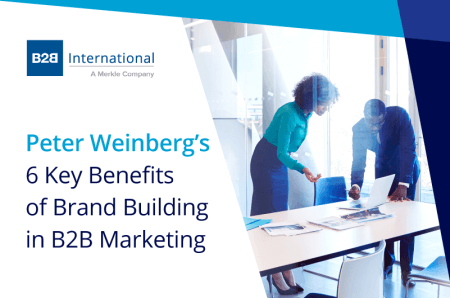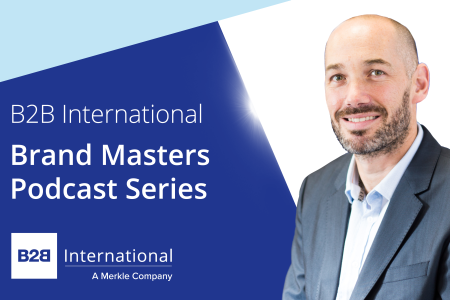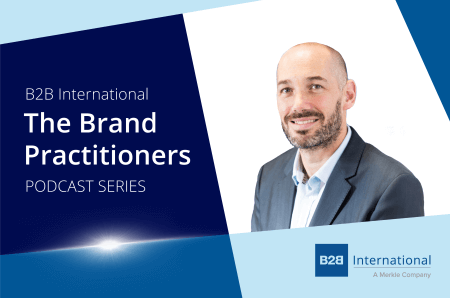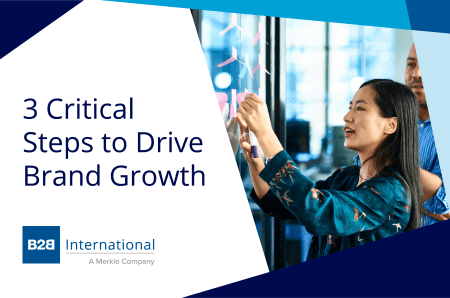
We live in a world of instant gratification, and with the average tenure of any CEO being less than 2 years it is of no surprise that CMOs are under pressure from the CEOs for instant results. As a result, sales activation is at the top of their priorities.
Evidence is therefore needed as to the power of brand building and why this should become a priority for the C-Suite as opposed to this sales activation trend (95% of B2B campaigns running on a “cost per click basis” for example). We asked Peter Weinberg, Head of Development at LinkedIn’s B2B Institute, to take us through the 6 benefits of brand building from some of The B2B Institute’s latest research…
1. Brand building improves short term results
“I think if you want to just be realistic, sometimes it’s very hard to change the time horizon that a company cares about. A lot of companies are just wired in a very short-term way, especially in B2B where you’ve got sales teams that are compensated on a quarterly basis. It’s very hard to get people like that to care about sales that are 5-10 years out.
“Therefore the easiest way to make the case for brand is just to say that it absolutely does have short-term benefits. Some of the experts we work with would argue that it’s something of an own goal to talk about the long-term benefits of brand in isolation when there are short-term benefits. You are much more likely to buy a product in the short-term that you have heard of. In fact, you cannot buy a product that you have never heard of; it’s impossible!
“That’s why brand tracking research is fundamental to brand strategy for any business. We see this in our data, Binet and Field see it in their data; essentially just that brands cast a halo effect at the bottom of the funnel. Once you are making sure people have heard of the brand in addition to just asking them to buy something right now, your CPLs go down, your conversion rates go up. Therefore there are real short-term benefits to brand building, even if most of the effects are long-term.”
2. Brand building improves future sales from future customers
“I think this is really the key idea. I think we have a problem in our industry which is our funnel. The funnel is the foundational mental model in marketing, and I think it’s problematic on a few different levels. But what we’ve been thinking about at the [B2B] Institute is can you basically flip the funnel on its side? So, you take this vertical funnel, you lay it horizontally, and then essentially you think about growth over time.
“I would argue any B2B business, and also any B2C business, really has two very different customer segments; people who are actively in market to buy the category and then people who are not in market today but will be in market in the future (whether that’s five days from now, five months from now, even five years from now). Everyone in our industry is obsessed with figuring out who is in market based on some sort of intent signal and converting them to buy right now.

“However, I think what our research with the Ehrenberg-Bass Institute has shown, an idea called the 95:5 rule from Professor John Dawes, is that only 5% of buyers are in market at any given time. There is a very small window of opportunity (c. 5% of buyers are in market, 95% of buyers are out of market). So usually when marketing drives growth, it is not by getting these in-market buyers to buy today. It is about influencing any future customers so that when they go in market, they think of your brand and whatever brand comes to mind at that moment is usually the brand that gets bought (brand awareness research is therefore central to any brands success).
“I think one reason we’re very fond of this idea is because it is a mental model that looks a lot like the CFO’s mental model. So essentially CFOs think in terms of current and future cash flows; so how much money you are going to make today, how much money you’re going to make in the future, and somewhat contrary to popular belief – future cash flows matter a lot more than short-term cash flows. So, some analysts would tell you c. 80% of the value of a stock is based on sales 10+ years in the future.
“A big problem in brand marketing is that we talk about it in this very fluffy way, like it’s an arts and crafts project that’s just like a “cute, adorable thing” for a business to do. I think an alternative way to frame it would be businesses are valued based on future cash flows and future cash flows come from future customers. Brand marketing is the only type of marketing that influences future customers. Telling somebody who is not in market to “buy now, buy now” when they’re not going to buy it for five years; that’s never going to work. It is more about the emotional brand creative that makes the brand salient in a future buying situation. So that is the financial case for brand marketing and the fact that it drives future cash flows, which is the lifeblood of any business.”
3. A powerful brand demands a stronger pricing power
“There are sales benefits to marketing, but ultimately marketing is a much bigger job than sales. It does a lot of other things for a business; the benefits of marketing are broad and multi-faceted, and marketers need to communicate that to their internal stakeholders. If you think of marketing in a very narrow way i.e., how many sales can we get tomorrow, you are going to spend all of your money on short-term ‘Performance Marketing’.
“Pricing power is one of those things that is a very real business benefit of brand marketing that we don’t think about or talk about a lot in our industry. Back in the golden days, pricing was part of marketing; it was one of the four P’s. However, it was stolen from the marketing department and given to the finance department, but just because the marketers don’t set the price anymore, it doesn’t mean they don’t affect pricing sensitivity. I think a lot of the experts we have worked with, especially Professor Mark Ritson, who I know you spoke to recently, would argue that the ability for marketers to reduce pricing sensitivity is one of the single most valuable things a marketing department does. It might even be more valuable than driving sales.
“So, Ritson makes the point that if you increase your pricing 1%, you can get a 10% lift in profitability. If you increase your sales volume 1% you get something like a 3% lift in profitability. So, there is this magic lever a business can pull to increase its profits, which is increasing its pricing, and that is something marketing allows businesses to do. Premium brands can charge premium pricing. So, people need to think about brand building not just in terms of its effect on sales but in terms of its effect on pricing power, (which Warren Buffett would argue is the most important thing a business has).”

4. Brand building gives optionality
“This is another under sung benefit of brand building. Categories are mortal and brands are immortal, right? Every category eventually goes into decline or stagnates, and there’s another new category growing faster. Brand is an escape pod that lets you move into new and growing categories. Microsoft would be a classic example; Microsoft pivoted from Windows to the Cloud, but they kept the same brand, “Microsoft”, that was known and trusted by every IT buyer on the planet.
“So, the problem is if all your marketing is solely about your product and your product features and specifications, your product is going to change. In the Tech industry it’s probably going to change pretty soon. So once the product changes, if all you were doing was building equity on the product, then essentially, you’ve got to start from scratch. If you are building equity on the brand (which sits above the product) then you can constantly be changing the product. You can be moving into new and growing categories, but still capitalizing on this brand equity that you’ve built over the course of many, many years.
“So, another financial benefit of brand building is not just its effect on short-term sales, on long-term sales, or on pricing power; it also allows you to move into new and growing categories.”
5. The power of your brand lends itself to attracting and retaining the best talent
“A lot of CEOs say that talent is their number one priority. I have no idea if that’s true, but let’s pretend it’s true for a second. Marketing has a very strong effect on your ability to attract and retain talent. Just like buyers want to buy from famous brands they’ve heard of, people want to work at famous brands they’ve heard of.
“We see this in our data – people do a lot of recruiting on LinkedIn – we see people are much more likely to respond to a recruiter if they’ve been exposed to some sort of brand marketing message. You want to work at companies that you’ve heard of – it’s that simple. It is another benefit of brand building beyond its effect on short-term sales that is very real and very valuable. Especially in Tech where there is a current war for engineering talent – a strong ‘employer brand’ is a major competitive advantage.”
6. Brand building enables an organization to create a competitive moat
“Performance Marketing, and what marketers are doing at the bottom of the funnel is very easy to copy. If you go talk to a bunch of B2B marketers, they are all pretty much doing the same thing at the bottom of the funnel; buy now, buy now, capture a lead, put it into a marketing automation system. We have all seen it a million times before.
“However, what they are doing at the top of the funnel, their brand marketing, is highly proprietary. To use a Warren Buffet term; it is a moat, and it is a moat in two ways.
“Firstly there is the time moat where it takes a while to build a brand which makes it relatively hard for new brands because they have to compensate for the work that’s already been done by their competitors. There was some research which found if you tried to launch a competitor to Coke, you would need to spend circa. $80 billion to compensate for the 100 years of brand building that Coke has done which has compounded over time. So, the fact that brand building is long-term and that it requires big investments over time, this creates a moat because it’s very hard for new entrants to catch up with the years that they’ve missed.
“Then there is the legal moat which is pretty straight forward, where you can’t copy another brand’s name or logo or distinctive assets to use an Ehrenberg-Bass term. Those are legally defensible trademarks, which is just another form of moat. So, your brand is a moat and I do not think the bottom of the funnel is much of a moat as far as I’ve seen.”
Listen to the full podcast discussion below.
Readers of this article also viewed:
- Running a Successful Brand Tracking Program
- The Importance of Measuring Brand Strength
- Brand Trust and Loyalty in B2B Companies



